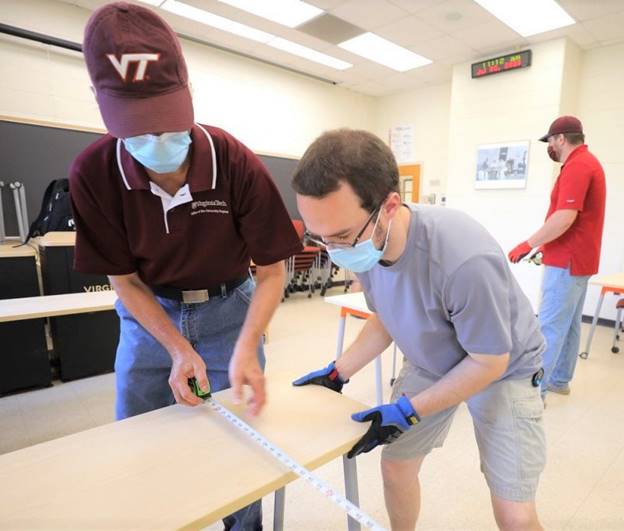
A university team works to reconfigure classrooms to meet physical distancing requirements
When the coronavirus hit in the spring, Virginia Tech rapidly moved its courses online, which was an unexpected emergency pivot that came together in the course of weeks. Now, as Hokies prepare for the return of students for the fall semester, the university is launching new practices to improve its academic experience amid the uncertainty of the pandemic
These changes represent not just an effort to innovate under challenging conditions, but to create systemic improvements whose effects will long outlast the pandemic that created or accelerated them.
“There will be permanent changes as to what it means to go to college as a result of the challenges we’re experiencing right now,” said Dale Pike, executive director and associate provost for Technology-enhanced Learning and Online Strategies (TLOS). “The face of work has likely changed permanently in our country as a result of being forced into this extreme version of teleworking. The same is true for education. While things are challenging right now — and we will certainly return to some largely physical experience once it’s safe to do so — we’re also finding ways to do things that will ultimately improve the way we teach and learn over time.”
Virginia Tech faculty are preparing to engage students through various modes of instruction: online, both through independent learning (asynchronous) and scheduled meetings (synchronous); face to face; and a hybrid approach that blends the others.
Of undergraduate courses, six percent will be face to face, 32 percent hybrid, 44 percent synchronous online, and 18 percent asynchronous online. Of graduate-level courses, 11 percent will be face to face, 29 percent hybrid, 41 percent synchronous online and 19 percent asynchronous online.
Developing a plan for fall instruction has been a challenging process complicated by the rapidly shifting dynamics of the coronavirus pandemic.
“Students, parents, faculty and staff are all looking for clarity as to what’s happening in the fall,” said Pike, “and yet, all things being considered, perfect clarity is impossible. What we can do is plan for likely scenarios, and that’s what’s happening. Balancing the need to come together to learn and the need to be safe from public health risks is a constant tension that I think happens and is felt at every level of the organization.”
Since May, 350 faculty members have attended one of the monthly course design clinics the school offered. The clinics guided faculty through the course design and redesign process using faculty keynotes, Zoom meetings, discussion groups, customized consultations and the Canvas site. Kim Filer, associate vice provost for teaching and learning and CETL director, said the center completely overhauled its approach to design clinics in May to make them models of best practices for online teaching.
“What has come out of this whole situation is that we have amazing faculty at Virginia Tech who are truly inspiring to each other,” Filer said. “All we’ve done at the course design clinic is to provide a venue in which faculty see all the amazing things going on, learn from each other, problem solve together, and then design inspired courses. The goal is for them to walk out of the clinic feeling like they have a community of people to reach out and talk to. We want them to feel inspired to try new things and empowered to go into the next wave of teaching.”
As faculty and staff have prepared for the fall, “communities of practice” also have emerged around different kinds of courses, such as arts, writing-intensive, large lectures, science and engineering lab, and seminar and discussion courses.
These communities are driven by faculty from different geographic and disciplinary backgrounds coming together as a team.
“We try to structure moments where faculty are inspired by their colleagues and are learning from each other,” Filer said. “Faculty really like to see each other. Being online allows more interaction between people who don’t often get to see each other. That doesn’t often happen in a face-to-face environment with people who don’t work in the same department or building. But now, online, they’re interacting with people across departments and in different parts of Virginia.”
The teaching and learning operations team also created three working groups that intersect with all five communities of practice. These groups focus on testing, proctoring and assessment; accessibility and accommodations and computer labs and virtual software delivery.
These working groups and communities of practice are preparing for the specific challenges of fall 2020, but they are developing and implementing tools and processes with long-lasting ramifications for the academic experience at Virginia Tech. The changes were implemented as part of Tech’s commitment to its Principles of Community, but they carry the potential to benefit any student who chooses to utilize them, regardless of need.
Classes begin Aug. 24.


